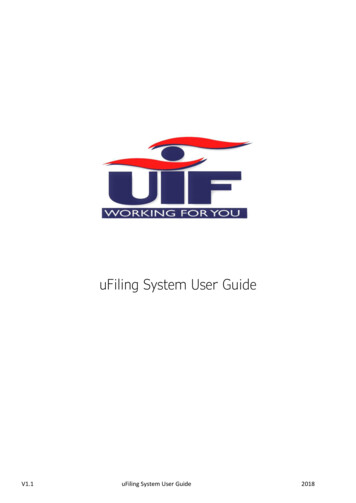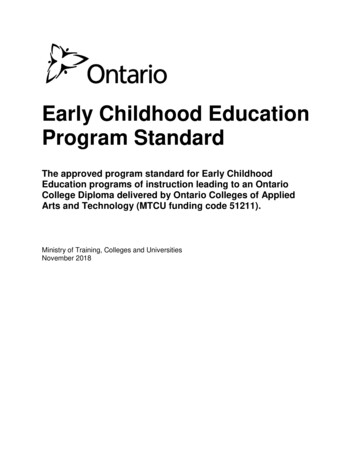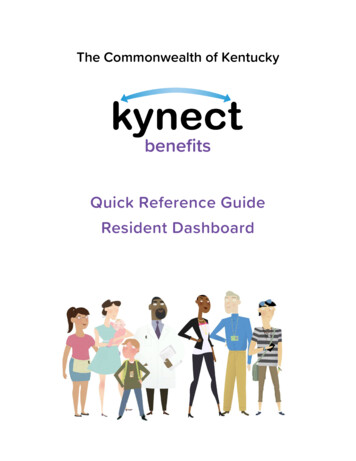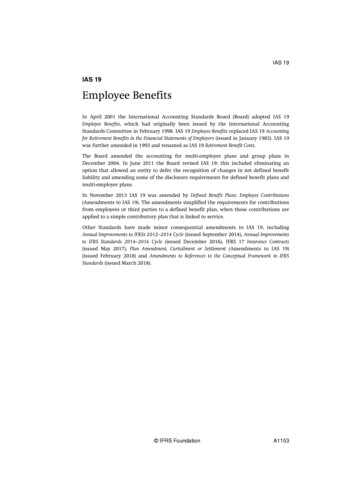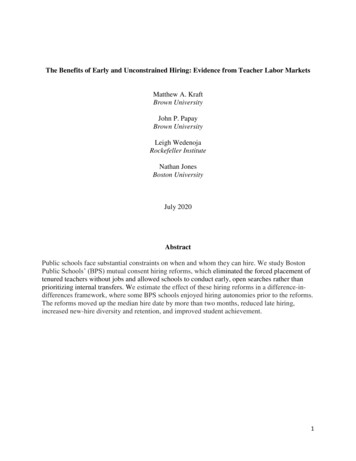
Transcription
The Benefits of Early and Unconstrained Hiring: Evidence from Teacher Labor MarketsMatthew A. KraftBrown UniversityJohn P. PapayBrown UniversityLeigh WedenojaRockefeller InstituteNathan JonesBoston UniversityJuly 2020AbstractPublic schools face substantial constraints on when and whom they can hire. We study BostonPublic Schools’ (BPS) mutual consent hiring reforms, which eliminated the forced placement oftenured teachers without jobs and allowed schools to conduct early, open searches rather thanprioritizing internal transfers. We estimate the effect of these hiring reforms in a difference-indifferences framework, where some BPS schools enjoyed hiring autonomies prior to the reforms.The reforms moved up the median hire date by more than two months, reduced late hiring,increased new-hire diversity and retention, and improved student achievement.1
I. IntroductionEconomic models of employee search and job matching predict that firms have thepotential to realize substantial productivity gains by improving their hiring practices (Lazear andOyer, 2009). The returns to improved search and screening processes are thought to beparticularly large in sectors where productivity is heterogeneous across individuals and workerfirm pairings. However, there exists little empirical evidence on the actual return to improvedsearch practices despite their perceived importance (Oyer and Schaefer, 2011).In this paper, we provide direct empirical evidence of the benefits of hiring reforms in thepublic education sector intended to improve search practices on both the extensive and intensivemargins. Hiring is particularly consequential in public education, where teacher performance islargely decoupled from wages, few teachers are removed for their performance, and tenure lawsprovide experienced teachers with substantial job protections. The teacher labor market alsoprovides an advantageous context in which to study hiring for several reasons: 1) administrativedata allow researchers to estimate direct measures of employee productivity, 2) there existsconsiderable variability in productivity across individual teachers (Hanushek and Rivkin, 2010),and 3) teacher-school match quality is an important driver of productivity (Jackson, 2013).Ideally, hiring in the teacher labor market would be a two-way matching process. Schoolswould select candidates who best meet their needs and teachers would select schools where theycould best see themselves teaching. However, the teacher labor market often functions in waysthat can hinder effective matching, especially in large urban districts. Collective bargainingagreements and district policies often delay the hiring process and limit the flexibility ofprincipals to hire the teachers they believe are the strongest, best-matched candidates. In fact, inmany urban districts, one quarter to one third of all new teachers are hired after the school year2
starts, which imposes considerable costs on student achievement (Papay & Kraft, 2016). Thisconstrained choice and delayed timing cause many new teachers to apply widely and accept thefirst offer they receive rather than risk waiting for their preferred match.We study Boston Public Schools’ (BPS) “mutual consent” hiring reforms to provideschools with the autonomy to conduct early, open, and intensive searches for vacant teachingpositions and to hire their preferred candidate. For decades, BPS’ hiring process wascharacterized by the “late, rushed and information poor” practices found in most urban schooldistricts (Liu & Johnson 2006; Levin & Quinn, 2003). Teachers whose positions had beeneliminated (“excessed teachers”) could be administratively placed in other schools withoutprincipal approval, more senior teachers had substantial advantages in the internal transferprocess, and schools could not hire external candidates until quite late. In the years prior to thereforms, 26% of new hires in traditional BPS schools were hired late and 44% left their schoolsafter their first year, both signs of low match quality. We replicate the findings of Papay andKraft (2016) using data in BPS to show that late hiring lowers student achievement by 0.07standard deviations (σ) in math and 0.06σ in reading.Starting in 2014, BPS extended hiring autonomy to traditional district schools, acondition previously reserved for district turnaround schools and within-district charter schools.The district also eliminated administrative placements of excessed teachers and allowed schoolsto “open post” vacant positions for external candidates much earlier. We employ a difference-indifferences (DD) framework to examine the differential impact of these reforms on traditionalBPS schools compared to almost a third of the district schools that already operated with hiringautonomies.3
We find that the BPS hiring reforms indeed accelerated hiring timelines and reduced theprevalence of late hiring in traditional BPS schools by nearly 50 percent. The reforms also hadsubstantial positive impacts on teachers and students – decreasing turnover among new hires,increasing the diversity of new hires, and increasing student achievement in traditional BPSschools by 0.07σ to 0.09σ. These achievement impacts largely operated through improvedeffectiveness of new hires.This research provides rigorous empirical evidence on the value of competitive searchand hiring practices in the labor market. We build on recent studies examining districts’ effortsto improve teacher hiring via the selection process and financial incentives.1 Specifically, weprovide the first evidence on the impacts of mutual consent hiring reforms that have beenadopted in several of the large districts including New York City, Chicago, Denver andBaltimore and remain highly contested (Sawchuk, 2010). Our findings also extend the literatureon employer-employee match quality with evidence of increased employee retention andimproved effectiveness when both firms and workers are afforded more time, autonomy, andchoice during the search process. Finally, our analyses of the hiring reforms speak to the broaderliterature on the importance of managerial and organizational practices for both school and firmproductivity (Bender et al., 2018; Fryer, 2014; Bloom et al., 2015; Angrist, Pathak, and Walters,2013; Papay et al., 2020).II. Teacher Hiring in U.S. Public Schools1Research on the selection process includes Jacob, Rockoff, Taylor, Lindy, and Rosen (2018); Goldhaber, Grout,and Huntington-Klein (2017); Bruno and Strunk (2018). Research on financial incentives includes Glazerman et al.(2013); Steele, Murnane, and Willett (2010); Clotfelter, Glennie, Ladd, and Vigdor (2008); Feng and Sass (2018);Bueno and Sass (2019).4
The teacher labor market is characterized by a competitive search process with bilateralasymmetric information among both teachers and schools (Lazear and Oyer, 2009). Schools areattempting to maximize the general ability of new hires as well as the match quality between newhires, the school’s organizational practices, and the specific position. Candidates for teachingpositions are looking to maximize the utility they derive from a position and school context aswell, conditional on their general ability. A successful hiring process is one that produces ateacher-school match that is optimally productive for both sides – the teacher finds a schoolwhere she wants to teach and can have success, while the school finds a teacher who canpromote the organization’s goals. However, there are a number of unique barriers to the optimalfunctioning of the job matching process.Constrained ChoicePrincipals in most public schools face considerable restrictions on their ability to conductan early and open search for job candidates. State tenure laws, which provide teachers withsubstantial job protections, create strong incentives for districts to conduct an “involuntarytransfer” process. Typically, tenured teachers whose positions have been eliminated – due toschool restructuring or closure, budget cuts, or reductions in student enrollment – bid on or areplaced into open positions for which they are licensed (Boyd et al., 2011; Grissom, Loeb, &Nakashima, 2014; Levin, Mulhern, & Schunck, 2005). The imperative to provide job placementsfor excessed tenured teachers even leads some districts to “bump” non-tenured teachers fromtheir position, regardless of their performance, and sometimes without the input of principals orschool-based hiring committees.5
District policy and collective bargaining agreements (CBAs) often constrain whendifferent teacher candidates can be considered. In many districts, teachers who wish to transferschools must also be considered first during a “voluntary transfer” process before schools canhire external candidates (Levin, Mulhern, & Schunck, 2005). In some cases, principals have noinput about which teachers transfer to their school, while other policies require principals tochoose among qualified transfer applicants or interview and at least consider these candidates.While teachers unions are often solely blamed for such policies, many districts in statesthat have repealed tenure laws or explicitly prohibit collective bargaining still operate withsimilar hiring constraints. In states where collective bargaining is illegal such as Georgia,Arizona, and Texas, many districts willingly honor informal agreements with local teacherassociations and non-union professional organizations which secure important advantages forinternal transfers. In other districts, central offices still maintain close control over the hiringprocess. Schools often have limited autonomy and can still be subject to forced placements andconstrained choice even in a state like North Carolina where both tenure and unions are illegal.Late HiringThe voluntary and involuntary transfer processes described above contribute to thewidespread phenomenon of late teacher hiring. Complicated student enrollment projections,policies that allow teachers to announce their departure after the school year ends, and districtbudget processes that often rely on external political actors further delay job postings and hiring(Levin, Mulhern, & Schunck, 2005; Levin & Quinn, 2003). Recent estimates suggest thatanywhere from 11 to 30 percent of newly hired teachers are hired after the start of the schoolyear (Engel, 2012; Jones, Maier, & Grogan, 2011; Liu & Johnson, 2006; Papay & Kraft, 2016).6
These studies also show that late hiring is concentrated most in schools that serve largepopulations of low-income students and students of color.Ultimately, late hiring is detrimental to student learning. When teachers are hired afterthe school year begins, they have no time to plan curriculum or prepare instructional materials.They also start without the opportunity to establish a classroom culture that is supportive tolearning and where all students feel like they belong. In the absence of a permanent teacher,students are taught by substitutes, temporarily absorbed into other classes, or simply left underthe supervision of a rotating cast of administrators and other school staff. Papay and Kraft (2016)find that late hiring directly reduced student achievement by between 0.03σ and 0.05σ. They alsofind teachers hired late leave their schools at higher rates than their peers hired on time, likely aresult of lower-quality matches between teachers and schools.III. Hiring Reforms in Boston Public SchoolsPre-ReformPrior to its Human Capital Initiative in 2014, hiring in most BPS schools was a highlystructured, multi-stage process that prioritized teacher seniority and was heavily controlled bythe central office. In January, the district would conduct a district-wide staffing needs assessmentbased on programmatic changes, student enrollment trends, school closures, budget cuts andteacher licensing requirements (Phase 1). Typically, the district would notify around 400 of thedistrict’s 4,700 teachers that they would not have a position in their current school for thefollowing year and would place them in the “excess pool.”In mid-April, the district would begin the voluntary and involuntary teacher transferprocess (Phase 2). School principals posted vacant positions to an internal job board and tenured7
BPS teachers had ten days to apply. School leaders were required to interview all internalcandidates who applied and had to hire one of them as long as there were at least two applicants.At the end of this process there often remained a significant number of tenured teachers in theexcess pool either because they never applied to a position or were not among the internaltransfer candidates who were selected. These teachers bid on remaining jobs in their certificationarea in order of seniority (Phase 3). Once a position had three bids the central office wouldunilaterally assign the most senior teacher to the position. Any remaining teachers wereadministratively placed in open positions within their certification area. In some cases, thedistrict “bumped” probationary teachers from their positions to place unattached tenured teachersin jobs. External hiring (Phase 4) typically began in June, pushing the hiring process well pastthe end of the school year. By this time, some candidates had already secured positions in otherschools and school-based personnel were not regularly available to screen and interview newapplicants.In addition to hiring delays, the constrained hiring process in BPS also created a numberof other unintended consequences. Many principals deliberately attempted to hide vacancies oravoid having an excess pool teacher placed at their school. This was because principals oftenused the excess process as a quick and less contentious avenue for removing low-performingteachers from their school instead of the lengthy and an uncertain evaluation process. As oneBPS Principal described, “We all know of cases when a colleague closed out a position insteadof evaluating out an ineffective teacher,” (Johnson & Suesse, 2005, p.10). In 2009, 52% of newpositions were posted late in the summer after the voluntary and involuntary transfer process hadended (National Council for Teacher Quality, 2010). This practice left principals “scrambling inAugust to fill vacancies that we’d hidden to protect ourselves from a disruptive placement”8
(Boston Municipal Research Bureau, p. 6). Others would try keep excessed teachers frombidding on open position: “I did everything possible to discourage people from selecting myschool. I told them that we had a shooting the previous year near the school yard, that we don’thave parking—anything to make the school seem as unappealing as possible” (National Councilfor Teacher Quality, 2010, p.10). Finally, some principals simply chose to stick with lowperforming teachers in their building rather than risk having a vacancy filled from the excesspool. A principal explained, “The one you know is better than the one you don’t” given that “Ihaven't begun to see how low it can go” (Kraft & Gilmour, p.242).The Growth of Autonomous SchoolsLegislative changes over the past two decades enabled BPS to experiment with newschool models that afforded greater autonomy over hiring and other school operations. In-districtcharter schools (called Pilot schools locally) first began in 1998 with autonomy over budgets,hiring and staffing decisions, school calendars, curriculum, professional development, andcompensation approaches. In 2010, the Massachusetts state legislature authorized two new typesof semi-autonomous public schools – Turnaround and Innovation schools. By 2014, almost oneout of every three BPS schools was operating with hiring autonomy that allowed them to bypassthe internal transfer and administrative placement process and open post positions for externalcandidates early in the hiring process. These flexibilities created some tension in the districtbecause autonomous schools could effectively remove tenured teachers from their schools byeliminating positions, but they were not required to hire excessed teachers or receive teacherswho were administratively placed. The turnaround process placed additional pressure on theexisting system by requiring some schools to dismiss more than half of their teachers, many ofwhom were tenured teachers who then had to be reassigned to traditional district schools.9
Hiring ReformsIn early 2014, BPS rolled out a suite of hiring reforms built around two principles:ensuring that principals had the flexibility to hire any teacher they believed was the best matchedcandidate (mutual consent) and accelerating the hiring timeline. The district aimed to “to attractand hire the most diverse, qualified and effective teachers as early as possible” through twoprimary initiatives: ending forced placements and allowing schools to open post positions at thebeginning of the hiring cycle (Boston Public Schools, 2015, p.1). These reforms extended theflexibility and local control over hiring to all schools that had only previously been afforded toautonomous schools in the district.BPS substantially expanded hiring autonomy by ending the practice of administrativelyplacing excessed tenured teachers into vacant positions. Instead, the district assumed the risk ofpaying the salaries of all teachers in the excess pool who did not obtain a job through the opensearch process. At the same time, the central office took a variety of measures to reduce thenumber of tenure teachers in the excess pool, including providing job placement supports,subsidizing training for new certifications, offering early retirement incentives, and dismissingteachers with low evaluation ratings. Teachers who failed to obtain a job offer were placed in aposition of “suitable professional capacity,” (SPC) typically serving in supplementalinstructional roles such as teachers’ aides, academic interventionists, and long-term substitutes.The intent was to place these teachers in roles in which they could grow professionally in hopesof improving their job candidacy for the following school year.To accelerate the hiring timeline, the district worked within the structure of the existingcollective bargaining agreement. It took advantage of a rarely used provision that allowedschools to skip the internal transfer process and open post positions immediately by attaching a10
1,250 stipend to any new position that required additional duties. The district committed topaying this one-time stipend for every vacant position in traditional BPS schools. Thiseffectively eliminated the internal transfer process and created a district-wide open postingsystem. Now all principals and school site committees in BPS had the autonomy to hire thecandidate of their choice among a pool that included both internal and external job candidates.Together, these reforms eliminated Phases 2 and 3 of the old hiring process, shifting externalcandidate hiring from mid to late summer to the spring.2Theoretical PredictionsHiring reforms such as those in BPS could improve the ability of new teacher hires,teacher retention, and ultimately student achievement through several theoretical channels. First,they allow principals to select the best candidate among a larger and higher-quality applicantpool instead of a small, negatively selected pool of involuntary and voluntary transfers. Second,they allow districts to attract job candidates by eliminating the risk that even a high-performingearly-career teacher could be “bumped” from their position. Third, they allow schools to bettercompete for job candidates given first-mover advantage in an uncertain hiring market. Fourth,they provide time for more robust candidate screening efforts (Goldhaber, Grout, andHuntington-Klein, 2017; Jacob et al., 2018; Bruno & Strunk, 2018).Mutual consent hiring reforms could also improve the productivity of new hires byenhancing match quality. The fit between a teacher and the culture at a school play an outsizedrole in the search process for teachers because wage schedules differ very little across districts2The district also undertook three related initiatives that stood to benefit both traditional and autonomous schools:merging the Office of Human Resources with the Office of Educator Effectiveness to create a unified Office ofHuman Capital; offering training and resources to aid principals in the hiring process, and expanding targetingrecruitment efforts to attract more teacher candidates of color. Our estimates will also capture any differential effectsof these reforms on traditional schools relative to autonomous schools.11
and do not vary within districts. Jackson (2013) shows that teachers seek out better matcheswhen transferring schools. Better matches may also result from pairings that maximize teachers’task-specific human capital across specific subjects (Fox, 2016; Goldhaber, Cowan, and Walch,2013) and student populations (Aaronson, Barrow, and Sanders, 2007; Dee, 2004; Loeb, Soland,and Fox, 2014; Masters, Loeb, and Wyckoff, 2017).Mutual consent hiring reforms would likely improve match quality through two primarychannels. First, they allow principals to select candidates who share their schools’ values andhave skills that align well with the specific job opening. Second, they give external candidates awider pool of job openings to consider and more time to search. Providing teachers and schoolswith more options during the search process can create gains through allocative efficiency.Improvements in match quality might also lead to a virtuous cycle of reduced teacher turnoverallowing for more sustained on-the-job improvement. Papay and Kraft (2016) find that teachershired after the school year starts leave their school at higher rates than on-time hires. On average,teachers who stay longer on the job become more effective by increasing their general and taskspecific human capital (Papay & Kraft, 2015; Cook and Mansfield, 2016; Ost 2014).IV. DataBPS is the largest district in Massachusetts, serving approximately 54,000 students inprekindergarten through twelfth grade and employing over 4,000 teachers. BPS students comefrom diverse backgrounds: 41% of students are Hispanic, 34% Black, 14% White, and 9% Asian.Over 80% of all BPS students come from low-income households, while 30% of students areEnglish language learners and 20% have special education needs. On average, approximately21% of teachers leave their schools each year in BPS, a comparable within-school turnover rate12
as other large urban districts (Papay et al., 2017). Public school teachers earn tenure inMassachusetts after four years of service.We utilize a range of BPS administrative records on teachers, students, and schoolsacross the 2006-07 to 2017-18 school years. We construct two types of primary analytic datasets,a teacher-by-year-level panel and a student-by-year-level panel linked to students’ math andEnglish language arts teachers in 4th through 8th grade. For our teacher-level analyses, we restrictour sample to teachers who both appear in the HR records with a job code as “teacher” and whoare employed at a specific BPS school. This definition excludes specialists, substitute teachers,and administrators as well as district-wide curriculum specialists and teachers who providespecial education services across multiple schools.We focus most of our analyses on new hires to the district, any teacher who is in her firstyear teaching in BPS regardless of past experience in other school districts. We identify newhires using hire dates in the HR administrative records and crosscheck that these teachers havenot been employed in BPS in prior years. In Table 1, we provide descriptive statistics for varioussamples of new hires. Overall, we identify 3,343 new hire teachers between the fall of 2006 and2017, or approximately 280 per year on average. Almost three out of four new teachers in BPSare female, 65% are white, 15% are Black; 11% are Hispanic, and 7% are Asian. Most new hiresare novice teacher (55%) and hold master’s degrees (68%).HR records allow us to identify teachers’ start dates, the day teachers officially report tothe district for work. New teachers are expected to report to the district for a New TeacherInstitute on the Monday of the fourth week of August, two weeks before the start of the schoolyear. All teachers report on the Tuesday after Labor Day in September and classes begin on thefollowing day. We define a new teacher as a late hire if she is hired after the first day of new13
teacher orientation. In practice, late hire teachers are those hired in September, October, andNovember.3 Thus, all new hires fall into one of three categories: on time hires (hired betweenJune and August), late hires (hired between September and November), and other hires (hiredbetween December and March).4We combine these administrative data with detailed hiring records collected by thedistrict starting for candidates applying for open positions in 2010. These data allow us toidentity the hire approval date, when a school’s decision to hire a new teacher has been officiallyapproved by the district. This occurs when a school has interviewed the candidate, made an offer,the offer has been accepted, and the hire has been approved by the central office.V. Econometric MethodsWe estimate the impact of the BPS hiring reforms in several ways. First, we estimate theimpact of late teacher hiring on student achievement in BPS, documenting the potential forimproved outcomes by moving up hiring timelines. Second, we leverage the context of the BPShiring reforms as a unique natural experiment to estimate the direct impact of these reforms onthe types of teachers hired, on attrition rates for hired teachers, and on student achievement.Late Hiring Effects on Student AchievementWe replicate the primary analytic approach outlined in Papay and Kraft (2016) using amodel that exploits variation within-students over time and across teachers within each grade in agiven school and year. We code a time-invariant indicator (EVER LATEj) to indicate whether ateacher was initially hired into the district late and a predictor (NEWHIREjt) to indicate whether3Teachers hired after December 1st are considered long term substitutes by BPSWe do not include teachers whose formal hire date falls between December 1 and March 1 as late hires becausethese teachers are more likely mid-semester replacements for teachers who leave (e.g., for maternity leave) ratherthan true “late hires” who fill positions that were vacant at the start of the school year.414
the teacher was newly hired in the district in a given year. We fit different specifications of thefollowing model for student i with teacher j in grade g, school s, and year t.5𝑌𝑖𝑡 𝛽1 𝐸𝑉𝐸𝑅𝐿𝐴𝑇𝐸 𝑗 𝛽2 𝑁𝐸𝑊𝐻𝐼𝑅𝐸𝑗𝑡 𝛽3 𝐸𝑉𝐸𝑅𝐿𝐴𝑇𝐸 𝑁𝐸𝑊𝐻𝐼𝑅𝐸𝑗𝑡 𝛾𝑓[(𝐸𝑋𝑃𝐸𝑅𝑗𝑡 ) ] 𝑋̅𝑗𝑡′ 𝜉 𝛿𝑖 𝜃𝑠𝑔𝑡 𝜀𝑖𝑡(1)Parameters β1 β3, and their linear combination identify our three primary quantities of interest.The parameter sum (β1 β3) represents the differential effect on student achievement of beingassigned to a late-hired teacher’s classroom in her first year relative to an on-time-hired teacherin her first year. We decompose this total effect into a disruption effect (β3), the effect on studentachievement that only occurs in the year a teacher was hired late, and a labor market effect (β1),the average permanent effect of late hiring across all years a teacher is in the district, includingthe teacher’s first year.Student fixed effects (δi) account for any time-invariant differences across students whoare assigned to teachers hired late or on-time. School-by-grade-by-year fixed effects ( sgt )control for the non-random sorting of students or teachers to schools and any cohort effects –focusing our estimates on schools that had an on-time new hire and late new hire in the samegrade and year. We also include a vector of teacher-year-level averages ( X jt ) of students’ prioryear test scores and other demographic characteristics to account for classroom compositioneffects not captured by the student fixed effects.6 We also fit models where we replace student5In all cases we cluster our standard errors at the school-grade-year level to account for the fact that students in thesame school and grade are likely to share common unmeasured influences on their achievement.6We also include indicators for “other” hires to ensure that we include all possible students in the district. We omitthese coefficients from our tables and discussion for simplicity.15
fixed effects with student-level covariates, including a cubic polynomial of students’ prior-yearachievement test scores in both mathematics and reading, to instead control for sorting on timevarying student measures. For both models, we report results with and without a flexible set ofindicators for teacher experience to examine the degree to which difference in general teachingexperience between late and on-time hires are driving any effects we find.Hiring Reform Effects on Teacher CharacteristicsWe analyze the sudden and largely unanticipated hiring policy reforms using adifferences-in-differences (DD) approach, where traditional BPS schools serve as the treatedgroup and autonomous BPS schools serve as the comparison group. Using BPS schools thatoperated with autonomy prior to 2014/15 as the comparison group allows us to control for anydistrict-specific shocks to teacher labor supply or student achievement. Importantly, the hiringreforms likely had both district-wide effects and effects that were concentrated in traditionalschools. Our DD approach primarily identifies the latter, namely the joint effect of ending theinvoluntary and voluntary transfer process and allowing schools to immediately considerexternal candidates, flexibilities that autonomous BPS schools already enjoyed. However, it doesnot capture the full district-wide effect of the reforms. We explore the degree that the reformshad district-wide effects by
to improve teacher hiring via the selection process and financial incentives.1 Specifically, we provide the first evidence on the impacts of mutual consent hiring reforms that have been adopted in several of the large districts including New York City, Chicago, Denver and Baltimore and remain highly contested (Sawchuk, 2010).



